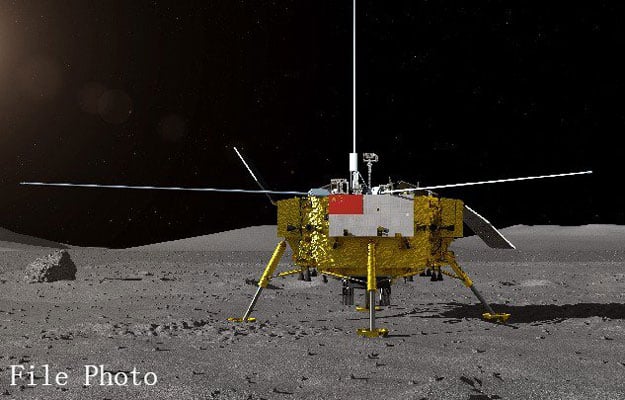China Makes World First Spacecraft Landing On Far Side Of The Moon
Several astronauts have explored the far side of the moon, but no spacecraft has touched the surface until now. China just successfully landed its Chang'e-4 probe in the Von Kármán crater. The China National Space Administration reported that the probe landed on January 3rd at 10:26am Beijing Time (January 2nd at 9:26pm EST).
The Chang’e-4 launched from the Xichang Satellite Launch Center in early December. The probe spent three days traveling to the moon and then a few weeks in orbit to prepare for its descent. Since the moon blocks radio transmissions, the Chang’e-4’s relay satellite was launched earlier this year. The Queqiao or “Magpie Bridge” is currently in the Halo orbit of the moon or 250,000 miles (400,000km) from Earth. Communications between the Chang’e-4 and the Queqiao were tested several times before the probe landed.

The Chang’e-4’s mission is to study the geological composition of the far side of the moon. The probe will collect and analyze minerals, study cosmic rays, observe the solar corona, and place potatoes, mustard seeds, and silkworms on the surface of the moon for observation. The lifeforms will be placed in containers with Earth-like environments, but they will be subject to weaker gravity.
This is not the first time China has landed a probe on the moon. The country successfully landed the Chang’e-3 in 2013, but its rover broke down within two months of landing. The main mission of the Chang’e-3 was to measure the depth of the lunar soil. The probe even discovered a new type of basaltic rock. It was the first probe to land on the moon since 1976.
China is not the only country or company that is interested in the moon. SpaceX is currently developing their Big Falcon Rocket (BFR) in hopes of pursuing long-duration space flights. Its first private passenger, Yasaku Maezawa, will get the chance to fly around the moon in 2023.
The Chang’e-4 launched from the Xichang Satellite Launch Center in early December. The probe spent three days traveling to the moon and then a few weeks in orbit to prepare for its descent. Since the moon blocks radio transmissions, the Chang’e-4’s relay satellite was launched earlier this year. The Queqiao or “Magpie Bridge” is currently in the Halo orbit of the moon or 250,000 miles (400,000km) from Earth. Communications between the Chang’e-4 and the Queqiao were tested several times before the probe landed.

Image from the China National Space Administration
The Chang’e-4’s mission is to study the geological composition of the far side of the moon. The probe will collect and analyze minerals, study cosmic rays, observe the solar corona, and place potatoes, mustard seeds, and silkworms on the surface of the moon for observation. The lifeforms will be placed in containers with Earth-like environments, but they will be subject to weaker gravity.
This is not the first time China has landed a probe on the moon. The country successfully landed the Chang’e-3 in 2013, but its rover broke down within two months of landing. The main mission of the Chang’e-3 was to measure the depth of the lunar soil. The probe even discovered a new type of basaltic rock. It was the first probe to land on the moon since 1976.
China also plans to launch Chang’e-5 in 2020 to collect samples from the moon and return them to earth. There is also a rumor that China will launch the Chang'e-6 in 2024. The Chinese Lunar Exploration Program’s ultimate goal is to land a crew on the moon and perhaps even build an outpost.What does the far side of the moon look like?
— China Xinhua News (@XHNews) January 3, 2019
China's Chang'e-4 probe gives you the answer.
It landed on the never-visible side of the moon Jan. 3 https://t.co/KVCEhLuHKT pic.twitter.com/BiKjh7Fv22
China is not the only country or company that is interested in the moon. SpaceX is currently developing their Big Falcon Rocket (BFR) in hopes of pursuing long-duration space flights. Its first private passenger, Yasaku Maezawa, will get the chance to fly around the moon in 2023.

